In This Article
Keyword research tells us how people are searching online. It starts with a seed – e.g. ‘flights to italy’ – and branches out into related keyword ideas like ‘flights to sorrento’, and metrics for those ideas – e.g. 720 searches in UK with Google last June.
Information like this is key to discovering the best new Google Ads campaign opportunities to supercharge our clients’ business growth, and the faster it can be accessed, the better.
Super Keyword Planner is a campaign research tool developed in-house to provide our team with faster and more fluid access to the highly useful & relevant keyword ideas most commonly sourced from the Google Ads Keyword Planner interface.
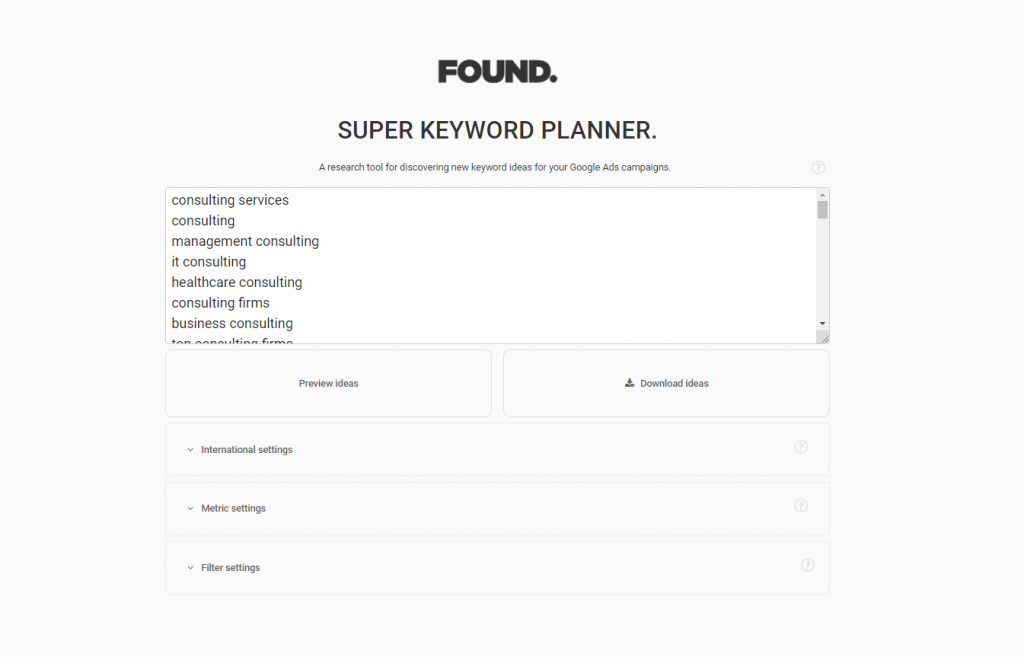
In this post, after a quick run-through of the features, I will cover what prompted me to start developing Super Keyword Planner, and take you through how it can be used to obtain search demand insights even more quickly when exploring new ad campaign ideas.
Super Keyword Planner in a nutshell
Super Keyword Planner gets keyword ideas & metrics for planning Google Ads campaigns quickly & easily.
Unique features:
- Built just for campaign keyword research
- Bulk retrieval of keyword ideas
- Multiple markets at once
- Minimal design
- Streamlined user journey
- Simplified spreadsheet export
- Mobile friendly
Benefits:
- Easier ad-hoc research
- Save time on campaign planning
What it really means:
- Keep your train of thought
- Say ‘yes’ to more research requests
- Get more done
- Put your feet up
Why Super Keyword Planner was created
Spreadsheet amnesia. It happens to the best of us. You’re staring at a keyword research spreadsheet you just downloaded from Keyword Planner. It’s got keywords. Search Volume. CPC. It’s really great. But why did you download it? You can’t remember why. You know there was a good reason. It’ll come back to you, maybe in a few seconds, maybe a few minutes. Point is, you were knocked off your train of thought. Why? Because you had to travel through the Google Ads interface to get to Keyword Planner.

In a bid to stop this happening any more, I developed Super Keyword Planner. It’s a web app – a light and nimble Keyword Planner overlay built to make keyword research faster and easier: 5x faster for small jobs and 30x for bigger ones.
This lets you keep your train of thought while getting keyword data, and makes keyword research available to those who normally wouldn’t have the time.
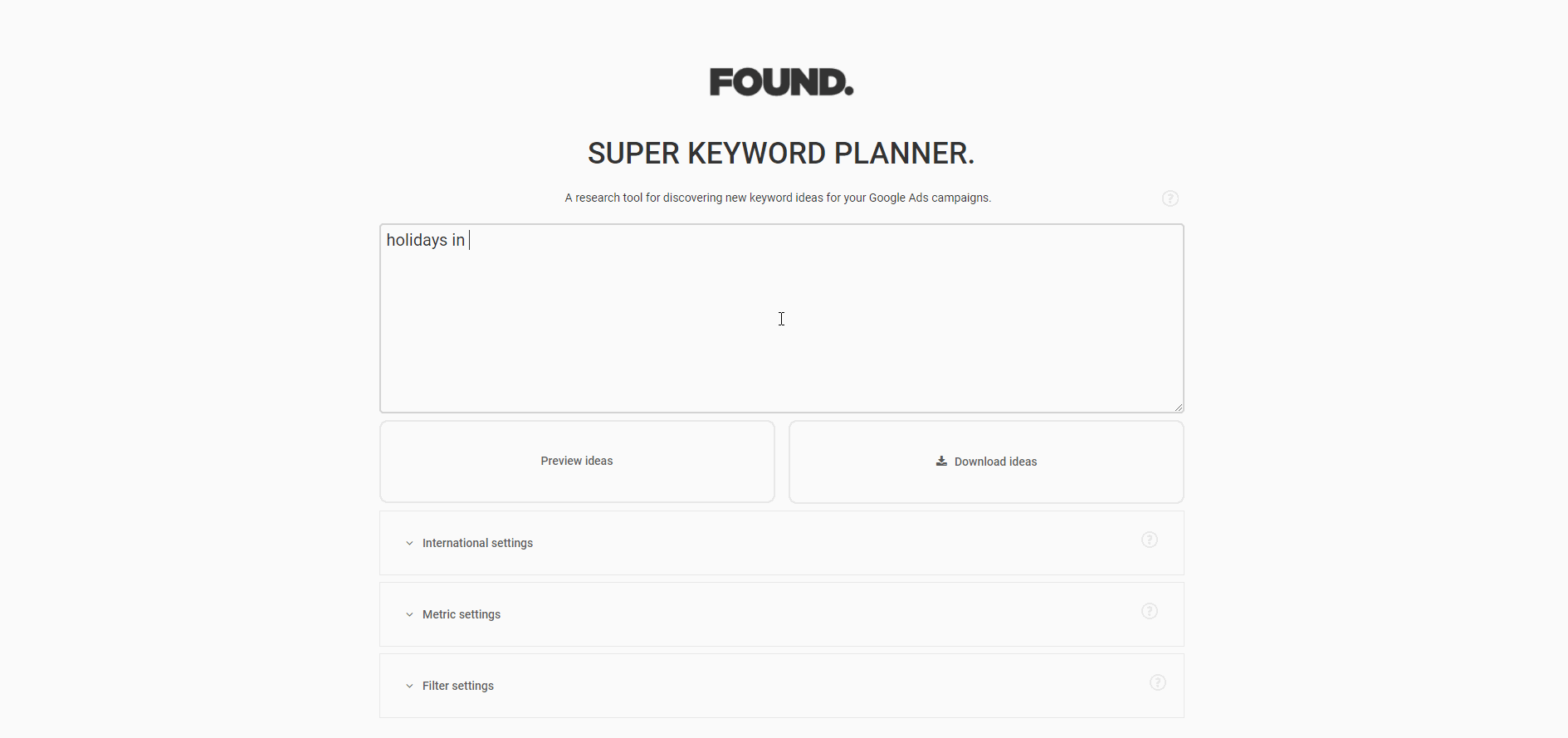
3 issues with using keyword planner for quick research
The process of getting keyword ideas from the Keyword Planner interface at the speed we need when exploring and planning the initial stages of Google Ads campaigns for our clients was something we wanted to work on. These were the key drivers:
#1 – Keyword Planner is nested within the Google Ads Interface
Loading delay and multiple steps
To get to the keyword ideas area, it’s necessary to wait for the Google Ads interface to load. It’s a fast load (4 – 6 seconds) if you consider everything it has in it, but that is no consolation to the quick keyword researcher with a fast-expiring flash of inspiration who doesn’t need to load up the whole interface at that moment. The interface takes a while because it has to prepare to do everything – it doesn’t know you just want a few keyword ideas for a new service your client has just asked you about.

When it’s loaded, you enter your keyword or URL seed, find and click the download menu button, choose between a Google Sheet or a .csv (which one should you go for this time?) and there’s the exported spreadsheet. Not bad, and packed with useful data, but because of the number of steps and the loading delays of unpredictable duration, you had to break your flow of concentration away from your work, to pay attention to whether Keyword Planner has loaded yet, and make sure you clicked in the right place. It’s not the end of the world. That is, unless it is necessary to go through this process multiple times, sometimes in a single day.
#2 – Keyword planner is more focused on researching single seeds
Just one tagged seed at a time
Often it’s not just one seed topic you need to get keywords for, but several. Sometimes clients ask us to research keywords for a large number of landing pages. The Keyword Planner interface lets you put in multiple seeds at once, but when you download the ideas, they are not tagged with the seed URL or topic. Your URL A keywords and URL B keywords are not labeled so you can’t reliably tell tham apart.
There is also a limit of 10 keyword seeds simultaneously (that’s without seed tagging) to be researched within the Keyword Planner interface. That’s not many for when deeper analysis is required when planning campaigns over a larger range of topics. Getting just one tagged seed topic at a time when putting together an analysis spreadsheet is like having to reload after every shot.
You can’t easily compare demand in different markets
In the Ads Keyword Planner interface you can choose multiple markets for which to get metrics for your keyword ideas, but as with the seed topics, the export doesn’t label them by market. Instead it combines the search volume together for all the markets, so a keyword with 100 searches in the UK and 40 in the US would just show as having 140 searches. If you want them separately to make a good comparison in a spreadsheet, you need to go one by one, get multiple downloads and stitch them together.
#3 – Keyword Planner is visually rich
Keyword planner has quite a lot of moving parts. There is a lot of visual activity to navigate if you are using it just for keyword research. Sometimes I find myself gazing at the beautiful seasonal graphs, one for every keyword, even the 10s. Useful for analysis, but if I didn’t need it (which is usually the case) it causes keyword research to take longer.
If I just want quick search volumes, this is a distraction. Mulling over the seasonality of a keyword when it doesn’t really matter can be all too tempting – why does interest for ‘nike lebron 17’ shoes peak in May? Doesn’t matter – my client doesn’t sell them (the answer is that the NBA playoffs happen in May).
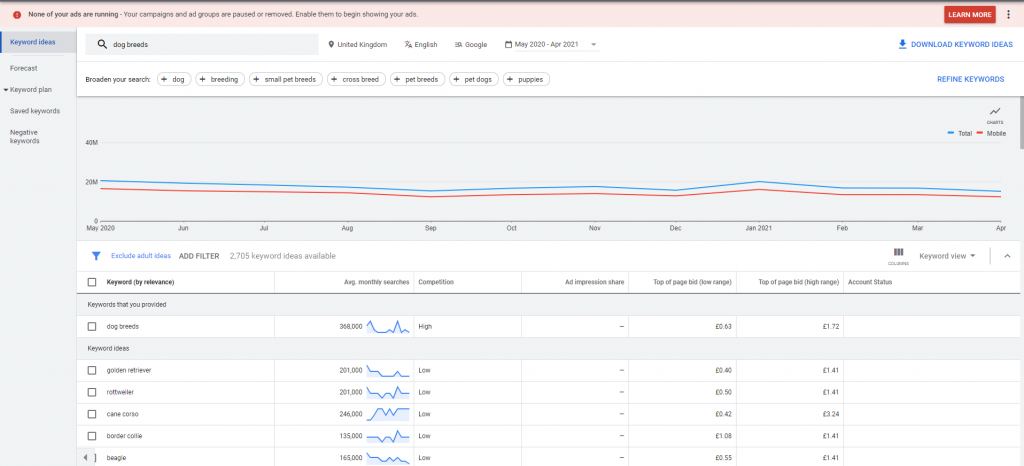
In the top right hand corner, there is often a bell with a red exclamation mark warning and tooltip, and then another red banner at the top. I don’t know about you, but I am the sort of person who has to get rid of things like that before doing whatever I was originally doing, even if I know it doesn’t matter for the moment because I am only there to do some quick keyword research.
Once I open the .csv download, I am given a wealth of information, more than I need to get a quick idea of demand around a topic for the initial planning stages of an Ads campaign. It would be great to see this without needing to delete rows or columns to make the sheet readable and pastable into other docs. The file names are also quite difficult to read and come back to later – there’s no getting a quick handle on ‘Keyword Stats 2021-05-15 at 17_51_28.csv’
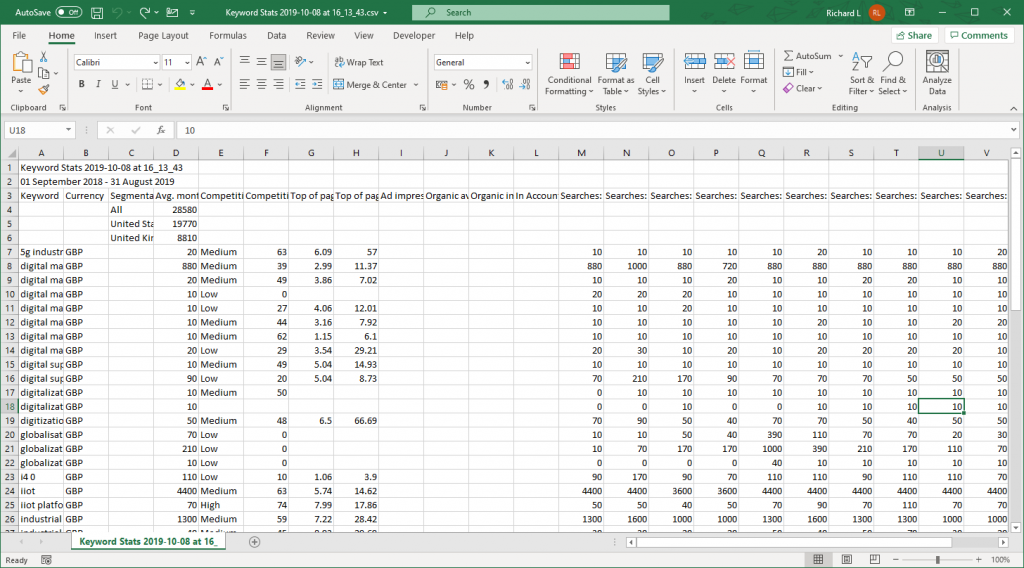
Aside from Keyword Planner, there is a variety of other keyword research tools out there which provide information tailored for the exploration of new campaigns, such as SemRush. However, they can be quite expensive. They also do lots of other things besides keyword research, which increases loading times, slowing them down if all you want to do is explore some quick keyword ideas. When it comes to the tasks we undertake multiple times daily – and keyword research for Ad Campaigns is one of these – speed is everything.
Getting there faster with Super Keyword Planner
Let’s imagine you need to research a couple of new business areas – you’ve got a PPC client who is considering branching into offering consulting services for cyber security and wants to know what the demand is for a potential Google Ads campaign. To get keyword research for these using Super Keyword Planner, you paste them into the big box and click the download button. The spreadsheet download appears a few seconds later.
The app home screen is tailored for initial exploration. There’s not much going on. The default spreadsheet download is simple, with just 6 columns as default vs. Keyword Planner’s 20+, making it easier to read.
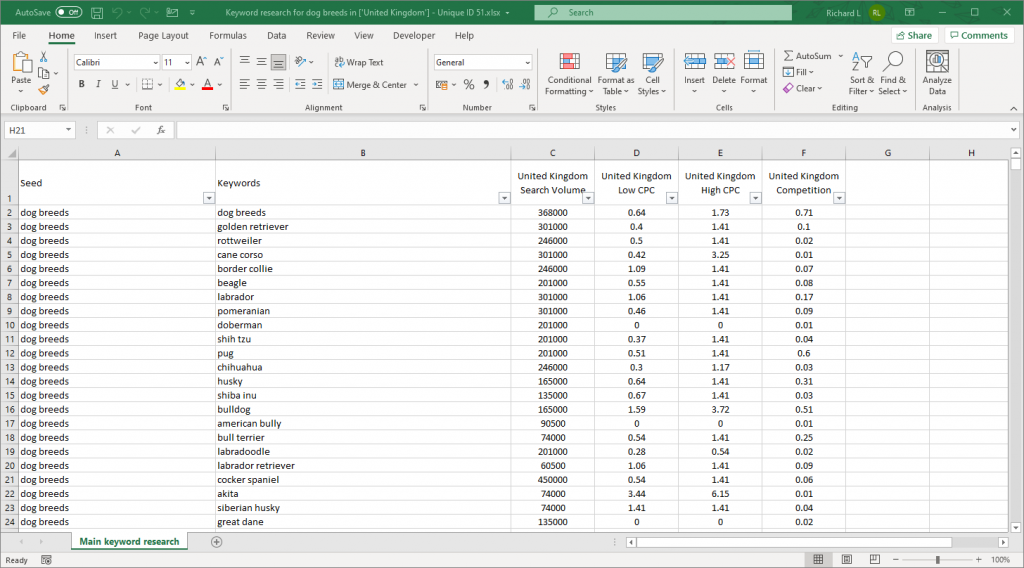
Unique features in depth
1. Bulk keyword research
It’s possible to get keyword ideas for multiple keyword or URL seeds at once. They are organised by the seed in the results spreadsheet, which makes it easier to work with the keyword ideas. For example, if a client wanted us to research 10 URLs for campaign targeting opportunities to potentially be rolled out in Google Ads, this information could be gathered and worked on all at once in a single spreadsheet, neatly tagged by the researched URLs.
2. Specially designed for purpose
Super Keyword Planner has big buttons and text areas. There is a streamlined user journey with no unnecessary options. It is fully responsive and mobile friendly, which means you can see a preview of Google keyword ideas on your smartphone in 5 seconds if you are out meeting a client. It has keyboard shortcuts, so you don’t even need to reach for the mouse – just hit ctrl + enter to preview keyword ideas.
The design principle was that the user should never be faced with any more options than necessary or be wondering ‘what does that do’. There are tooltips available to give tips on producing the most useful keyword research for your needs.
3. Multiple simultaneous markets
If your client is thinking about expanding their Google Ads campaigns internationally you can use Super Keyword Planner to give them international demand insight at the drop of a hat. In the options panel, when downloading, you can select as many markets as you like to get average monthly search volume, CPC & competition data, and seasonal volumes to track demand across the course of the year.
The market selection dropdown is logically categorised – English, Europe, Asia & World – including only the markets which are of a sufficient GDP size to be likely to be valuable campaign targets. It’s laid out in a way that puts all the markets you are ever likely to need right in front of you, vs. searching for every one in the Keyword Planner interface, as that has to cover all 200+ markets. One day we might need to research demand in Sao Tome & Principe which isn’t in the fast access menu, but there’s always the main Keyword Planner interface for rarer jobs like that.
The selected markets appear as floating buttons and can be added or changed with ease and simplicity.
When you’re ready, click ‘get keyword ideas’ (or just hit ctrl + enter if you like keyboard shortcuts) and sit back for a second as data is gathered for all of your markets at once without you needing to adjust any settings in-between.
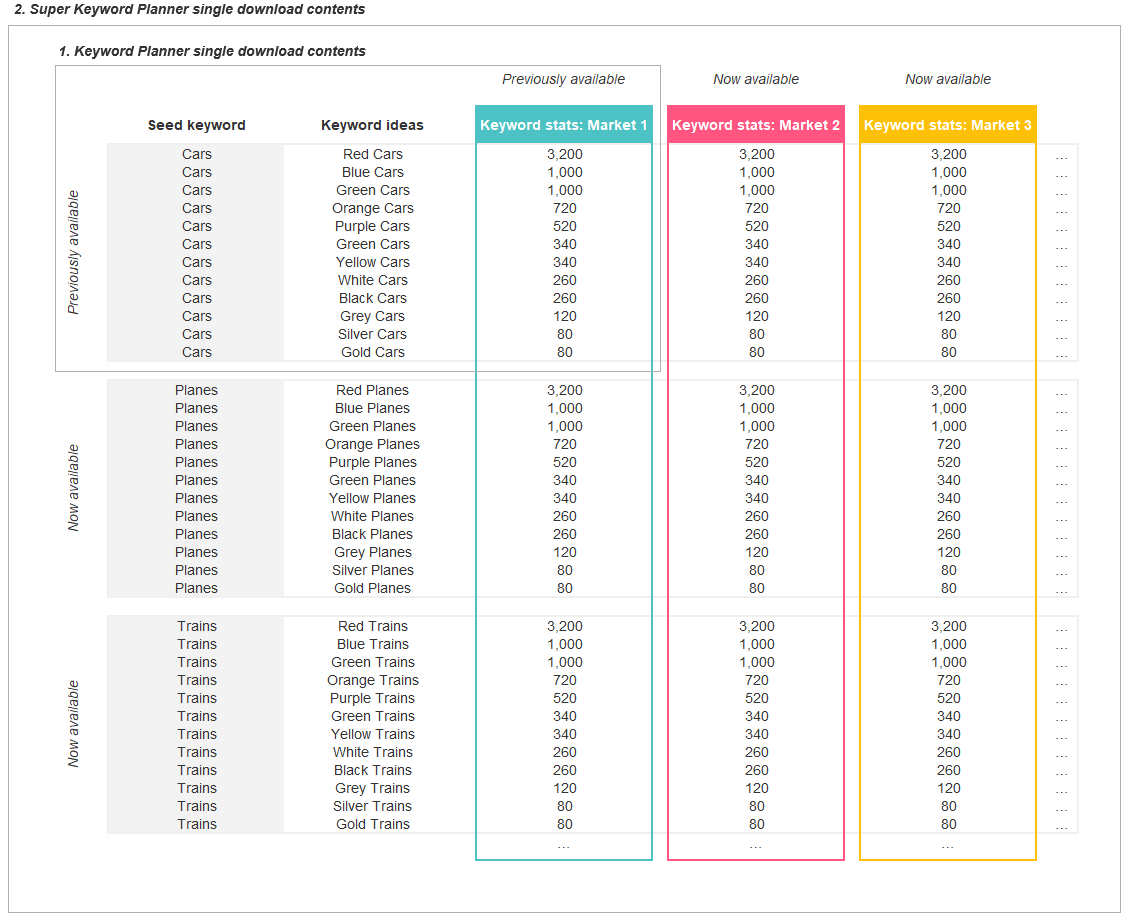
Other features
Keyword idea filters
Simplicity does not have to mean inflexibility. The intention behind keyword research can vary and so you may want to get different types of keyword ideas at different times. For example, at the start of a campaign, you’ll probably want the widest possible range of relevant keyword ideas as you get to know a product or service area. Later on, you’ll want to get more specific, narrowing down on the closest variants to perform detailed campaign optimisation. Or maybe you have some custom requirements for the type of keyword ideas you want returned, that aren’t quite covered by either scenario. Super Keyword Planner’s Idea Filter has 3 modes, one for each of these flavours of keyword research:
1. Idea Filter: Off
Returns a wide range of related keyword ideas, everything Google has. It is quite comprehensive and filled with relevant keyword ideas, but there will inevitably be some in there which are only tangentially relevant.
2. Idea Filter: Automatic
Automatic filtering is something unique to Super Keyword Planner. It limits the ideas returned to those which contain the words in the seed phrase. For example, for ‘hotels in london’, every idea returned would contain those words e.g. it would return ‘best hotels in london’ but not ‘hotels near london’. This will provide you with only the most directly relevant keyword ideas, but if there are any significant important alternative wordings for the core meaning of your seed keyword, these will be excluded. Therefore this setting is best used when you are already fairly sure about the broad way people search and want to zero in quickly on the closest variations for campaign optimisation.
3. Idea Filter: Manual
Super Keyword Planner gives you control over your keyword research, letting you set filters easily by typing or pasting filter words into simple text boxes. For example, you can prevent ideas from being returned if they contain, say, a competitor brand – just paste the brand list into the ‘exclude’ box.
If you want to narrow your research, you can provide a list of words, of which one at least must be included in a keyword idea e.g. if I include ‘rattan’ and ‘cheap’ for the seed ‘garden furniture’, every keyword idea returned will have either ‘rattan’, ‘cheap’, or both. If I am trying to narrow keyword ideas down using multiple words, I can put an asterisk after each word, which tells Super Keyword Planner that this word must be included in an idea if it is to be returned. For exampe, if i put ‘rattan*’ and ‘cheap*’ into the ‘include’ text box, all the returned keyword ideas would have to contain both ‘rattan’ and ‘cheap’.
Similar filters are available in the main Keyword Planner interface, but they can only be added one word at a time by clicking on small menus, and there is a limited number of filter words which can be applied. In Super Keyword Planner, you can paste in a list in a few seconds, and quickly switch between AND & OR filtering.
Preview mode
It would be hard to refine your keyword research if you had to keep looking in the spreadsheet downloads to see the ideas returned, then come back to the interface to add include or exclude criteria and download again. For this reason, Super Keyword Planner has a preview mode. For any seed in any market, it will give you a quick list of the keywords and their search volumes, just to give you an initial idea. This shows you what kind of ideas Google is returning so you can apply a quick filter, narrow down a few times, and then download a spreadsheet with the refined keyword ideas along with the CPC and competition metrics.
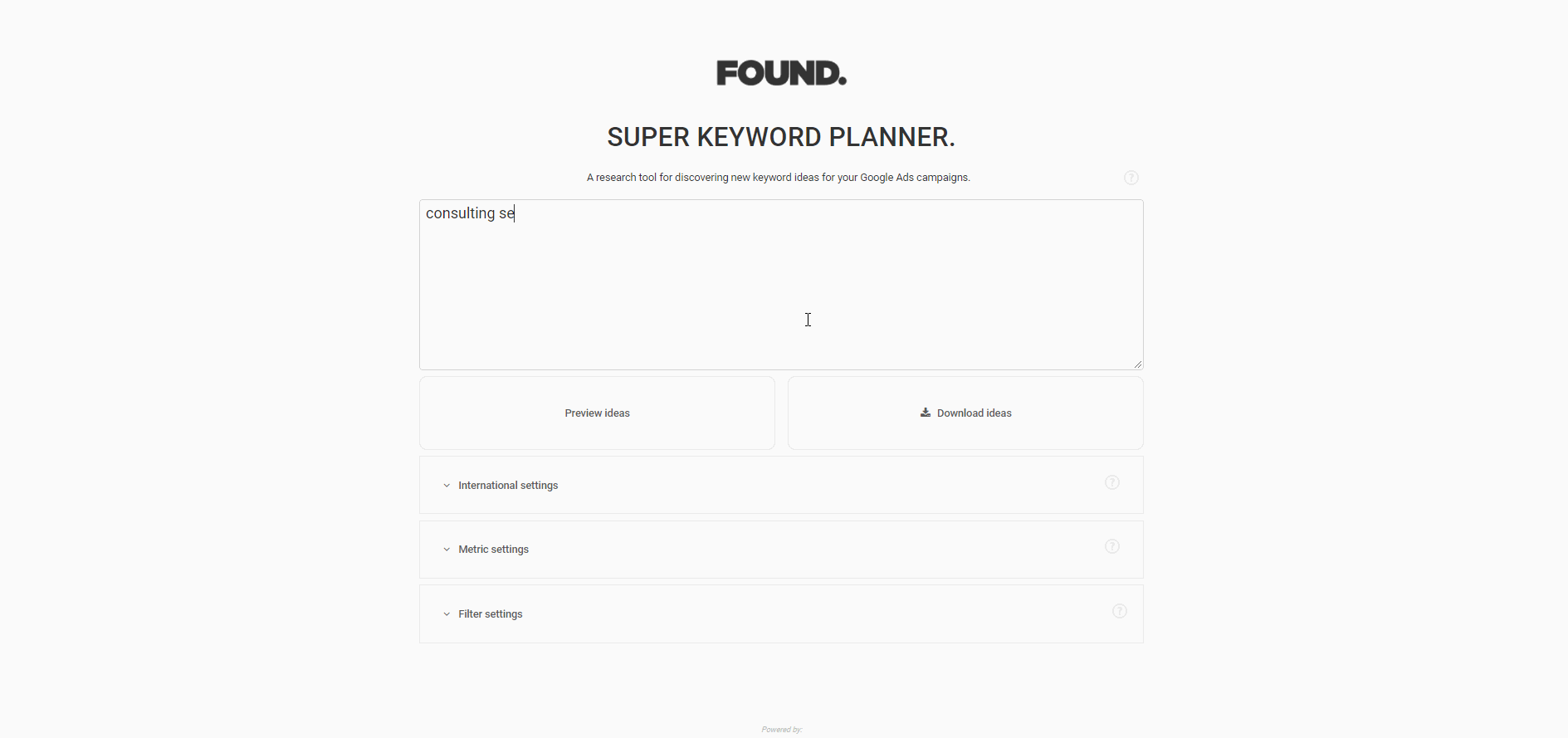
If you were doing generic keyword research for ‘consulting services’ and you saw that lots of keyword ideas with consulting brands were coming up which you did not want to target in your Ads campaign, you could get a quick preview and add the brands to the exclude list, then do another quick preview to see the effect it had, refining a few more times if you need to, and getting the download. This way, you don’t need to edit your spreadsheet after download. This part of the app is evolving, and will soon make it even easier to refine your keyword research in-app.
Speed improvements
Put to the test: Super Keyword Planner vs. Keyword Planner
We measured time taken and number of clicks needed for 3 Ads campaign keyword research use cases, from small to large. Time taken was measured from clicking on the link to the interface, to being presented with the file download dialog.
Use case 1: Quick check for 1 keyword
Desired output: a spreadsheet of keyword ideas and basic metrics for ‘travel insurance’ in the UK.
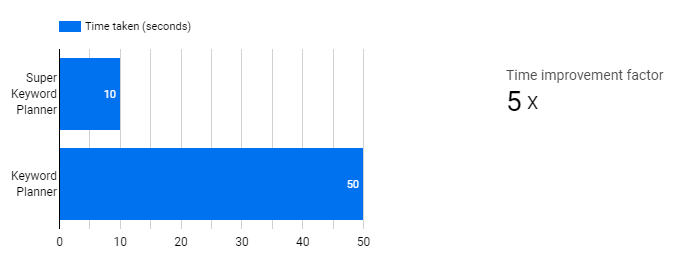

This kind of use case is the most common, for initial small scale planning in response to client queries about new service areas. Super Keyword Planner lets you get the data for this 5x faster and in just 2 clicks. This is quick and simple enough for you use in a conference call without taking your mind away from the conversation.
Use case 2: Filtered research for 3 keywords
Desired output: a spreadsheet of keyword ideas and metrics for ‘holiday insurance’, ‘travel insurance’ and ‘life insurance’ with the following filters: include ‘quote’ and ‘cheap’, exclude ‘ski’ and ‘medical.
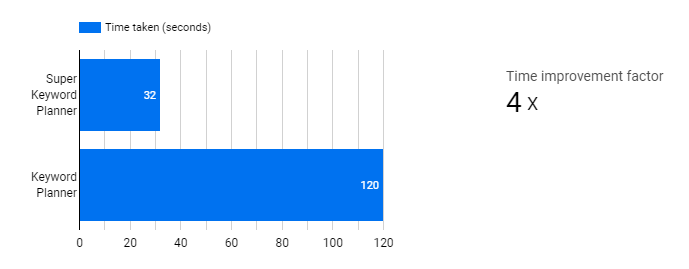
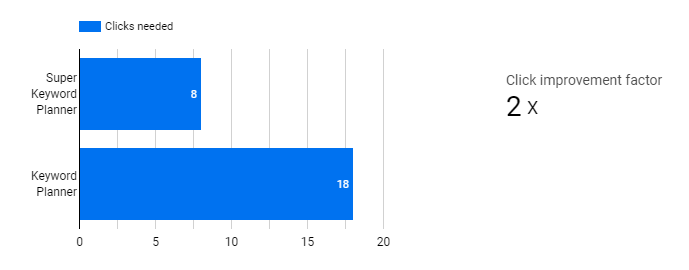
In the mid range, performance remains strong but is less striking than in the previous example as the user has already paid the costs of navigating through the Google Ads interface to get to Keyword Planner.
Use case 3: Research for 20 seeds in 3 markets
Desired output: a spreadsheet of keyword ideas and metrics for 20 keyword seeds in 3 markets.
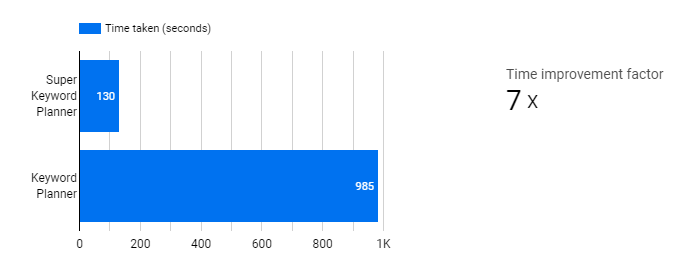
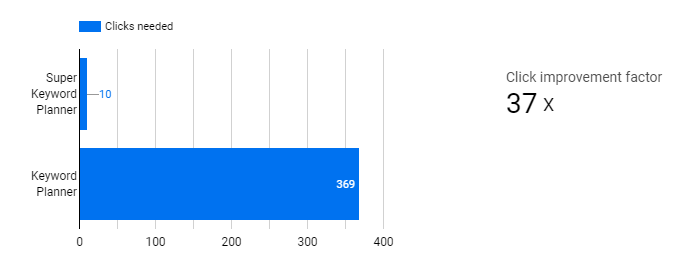
This is where the greatest difference shows, with the time savings accumulating as the number of keywords and markets increases.
The bottom line
The team at Found does keyword research daily, and the need for fresh research can arise at any time. The Super Keyword Planner web app provides quick leverage for delivering top quality keyword research for planning and exploring new Google Ads campaigns on demand and at scale for our clients. To put it simply, we can out-research the competition.

If you’re interested in how Found could supercharge your digital performance across SEO, PPC, Social and Digital PR, then get in touch today to speak to a member of the team.


